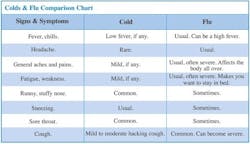Due to the nature of your work as law enforcement officers/officials, you are exposed to all kinds of nasty communicable diseases; especially the flu. Stop for a minute, close your eyes, and think of all the people you had contact with yesterday. Family members, friends, neighbors, partners, supervisors, office staff…citizens, suspects, occupants of a stopped car, crowd control, students...wait staff at a restaurant, cashiers, daycare…
Fact: People with flu can spread it to others up to about 6 feet away.
Now, how many surfaces do think you touched yesterday? Door handles/knobs, shared computers, radios, briefing room tables, suspects’ belongings/pockets, children’s toys, towels, glasses…
Fact: Most flu viruses can live one to two days on nonporous surfaces (metal, wood, plastic), and 8 to 12 hours on porous surfaces (fabric, paper, etc.).
Summary of the 2017-2018 Influenza – The Deadliest Flu Season in Over 40 Years
Last year’s flu was driven by a known virulent strain, which tends to cause more deaths and hospitalizations (particularly among young children and the elderly) than typically seen. An estimated 80,000 Americans died of flu and its complications last winter — the disease's highest death toll in at least four decades. Over 700,000 people were hospitalized. Making a bad year worse, the flu vaccine didn't work very well.
There really is no way in knowing what this season will bring.
Influenza Vaccination Information and Options
Bottom line: An annual seasonal flu vaccine for everyone 6 months and over is the best way to help protect against flu.
- The seasonal flu vaccine protects against the influenza viruses that research indicates will be most common during the upcoming season.
- Influenza A and B viruses are responsible for seasonal flu epidemics each year. Traditional flu vaccines (called “trivalent” vaccines) are made to protect against three flu viruses; influenza A (H1N1) virus, an influenza A (H3N2) virus, and an influenza B virus. There are also flu vaccines made to protect against four flu viruses (called “quadrivalent” vaccines). These vaccines protect against the same viruses as the trivalent vaccine but with an additional B virus.
- Different flu vaccines and doses are approved for different age groups. Ask your physician or pharmacist which is best for you.
- Injection of the vaccine is typically given in the right deltoid muscle (arm) for adults, children under three years in the anterolateral thigh muscle.
- The nasal spray flu vaccine is approved for use in non-pregnant individuals, 2 years through 49 years of age. People with some medical conditions should not receive the nasal spray flu vaccine.
- The CDC reports that this year there is no expressed preference for any flu shot or the nasal spray vaccine.
- Vaccine manufacturers have projected that they will supply as many as 163 million to 168 million doses of flu vaccine for the 2018-2019 season.
When to Get Vaccinated
You should get a flu vaccine before the flu begins spreading in your community. It takes about two weeks after vaccination for antibodies that protect against flu to develop in the body, so make plans to get vaccinated early in fall, before flu season begins.
CDC recommends that people get a flu vaccine by the end of October. Flu activity begins from September through November, and peaks between December and February, and can last as late as May.
The Flu Versus Cold: Facts
· Flu and the common cold are both respiratory illnesses but they are caused by different viruses. Because these two types of illnesses have similar symptoms, it can be difficult to tell the difference between them based on symptoms alone.
· In general, the flu is worse than the common cold. Flu symptoms generally come on abruptly, are more intense, and can have very serious associated complications.
· Symptoms of colds come on gradually. Colds generally do not result in serious health problems.
· There is a vaccination to prevent the flu; there is no vaccination to prevent a cold.
The following symptoms could indicate that your condition is severe. Get immediate medical help if you have any of the following: trouble breathing or shortness of breath; pain or pressure in your chest or belly; sudden dizziness; confusion; severe vomiting.
Complications of the Flu
Most people who get the flu can treat themselves at home and usually don't need to see a doctor. However, certain individuals, are at a higher risk for developing serious flu-related complications; children under the age of five (but especially younger than two), adults 65 and older, pregnant women, and those with chronic medical conditions. Some of these complications can be life-threatening and result in death, these include:
· Dehydration
· Sinus and ear infections
· Seizures
· Pneumonia
· Inflammation of the heart (myocarditis), brain (encephalitis) or muscle (myositis, rhabdomyolysis)
· Multi-organ failure: respiratory and kidney failure
· Sepsis
· Worsening of chronic medical problems
If you experience severe flu symptoms and are at risk for complications, see your doctor right away. Taking antiviral drugs within the first 48 hours after you first notice symptoms may reduce the length of your illness and help prevent more-serious problems.
You Got the Flu Anyway – Now What?
The CDC recommends that you stay home for at least 24 hours after your fever is gone. Stay away from work, school, public transportation, stores, social events, and public gatherings. According to the CDC; you are contagious one day before you start feeling sick and up to seven days after. Children, the elderly or people with a weak immune system can be contagious for even longer.
Maintain your flu manners; you do not want to share your misery with anyone else, especially your loved ones and partners. Reminders: wash or sanitize hands frequently, forego the handshake when meeting people, sneeze into your elbow not your hand, wear a facemask, properly dispose of tissues, etc., sanitize surfaces in the kitchen and bathroom.
The most important treatments at home are rest, hydration, and fever reduction. OTC medications are available to help with other symptoms; sore throat, cough, aches and pains, Yes, chicken soup is good for you. Kissing not so much.
A bout of the flu typically lasts one to two weeks, with the more severe symptoms subsiding in two to three days. However, weakness, fatigue, dry cough, and a reduced ability to exercise can linger for three to seven days.
Just for Fun: Debunking the “Man Flu” Myth
I assume that most of you have heard of the dreaded “Man-Flu”. Some of you may have experienced this debilitating illness, many more are susceptible, and others have served as designated caregivers for those suffering the excruciating symptoms:
Urban Dictionary definition of the “Man-Flu”: A rare strain of flu so powerful and so deadly it can only be matched by the Bubonic Plague and Aids. An incurable virus which has adapted to only effect the "XY" gene found in men. The virus attacks the immune system 10,000 times harder than the average flu virus, causing excruciating pain for the victim. Man-Flu is more painful than childbirth. More men die each year from MFN (Man-Flu Neglect) than lots and lots of other things. (Like rabbit attacks or choking on toast). Man-Flu germs are more powerful than superman and the A-Team combined. Man-Flu has no cure and prayers can save the forsaken life of the infected. The often-deadly virus is mostly laughed at by women who sadly cannot contract "Man- Flu"
Fact: However breaking news last year has proven that the “Man Flu” is indeed true. A clinical research study done last year at Memorial University of Newfoundland found evidence that adult men have a higher risk of hospital admission and higher rates of influenza-associated complications and deaths compared with women, regardless of underlying disease.
Meanwhile, stay safe and healthy out there.

Pamela Kulbarsh
Pamela Kulbarsh, RN, BSW has been a psychiatric nurse for over 25 years. She has worked with law enforcement in crisis intervention for the past ten years. She has worked in patrol with officers and deputies as a member of San Diego's Psychiatric Emergency Response Team (PERT) and at the Pima County Detention Center in Tucson. Pam has been a frequent guest speaker related to psychiatric emergencies and has published articles in both law enforcement and nursing magazines.



